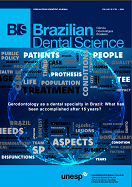Evaluation of Salivary and Serum Alpha Amylase Level in Dental Caries of Adolescence
DOI:
https://doi.org/10.14295/bds.2016.v19i2.1227Abstract
Objective: Some previous studies suggested a significant relationship between alpha- amylase, and caries formation. This study was implemented in order to investigate the interrelation between level of salivary and serum alpha- amylase and dental caries. Material and Methods: In this cross-sectional investigation, un-stimulated whole saliva and serum sample was collected from 118 high school students who were divided to four groups: Caries free female (N= 28), caries active females (N=35), caries free males(N= 28) and caries active males(N= 27). Mean levels of salivary and serum alpha-amylase was assayed by spectrophotometric method to assay enzyme kinetics. Data were analyzed using student’s t-test and chi-square test. Results: The results of this study demonstrated that salivary and Serum alpha- amylase were significantly higher in caries active group as compared to carries free group(P = 0.002, P= 0.001 respectively). In addition in male groups the mean salivary and serum alpha -amylase was significantly higher in caries active as compared to caries free (P = 0.002, P = 0.02 respectively) and in female Groups the mean serum alpha- amylase was statistically significant higher in caries active as compared to caries free (P = 0.01). Conclusion: The results of this study demonstrated significant association between salivary and serum alpha- amylase in adolescence with dental caries. More research should be done to demonstrate real relation between alpha amylase and dental caries.
Keywords
Alpha–amylase; Dental caries; Saliva; Serum.
Downloads
Downloads
Published
How to Cite
Issue
Section
License
Brazilian Dental Science uses the Creative Commons (CC-BY 4.0) license, thus preserving the integrity of articles in an open access environment. The journal allows the author to retain publishing rights without restrictions.
=================




























